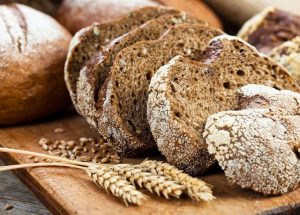
Stolichniy is one of the most popular varieties of Russian rye bread. It is produced from a mixture of rye-peeled flour and wheat flour of the 1st grade on rye sourdough with the addition of other raw materials. This healthy bread has been around since the Soviet time and close to Russians’ hearts. It is very delicate and has everything in moderation – it is moderately salty, moderately sweet, moderately sour, moderately black, moderately dense and moderately loose, with a bright, distinct aroma and taste, but at the same time not clogging the taste of other products and therefore perfectly suitable for sandwiches, soup, and everything you want including a quick breakfast.
The recipe
Despite the purpose of being an express meal, the making of Stolichniy rye bread is not that simple. It is even safe to say that the recipe belongs to the intermediate to advanced level of baking. But, of course, you can always try to make it yourself at home. Let us begin.
The most important step about making this Russian bread is the leavening, or getting the dough develop correctly. For this, you will need sourdough – preferential dough which contains natural yeast and a large number of lactic acid bacteria. You can find recipes to make this sourdough on the internet easily.
For dough you need:
- 140 g sourdough on rye peeled flour
- 77 g of water
- 132 g peeled rye flour
For the main batch:
- 100 g rye peeled flour
- 290 g of 1 grade wheat flour
- 240 g of water
- Approximately 1 g of dry yeast (not more)
- 9 g of salt
- 18 g sugar
For starchy jelly:
- About half a teaspoon of potato starch
- 50 g of water
Here are the steps to making the rye bread:
1. According to the recipe, you need a rather large amount – 140 g – of sourdough, if you have less, you can increase the required amount by adding equal amounts of flour and water to the available amount of sourdough.
2. For dough, add the amount of warm water necessary for the recipe to the sourdough, stir it so that the sourdough is almost completely dispersed, and then pour in the rye flour and stir until smooth. The result is a rather thick viscous mass. With wet hands we round it, smooth it.
3. Cover the bowl of dough with a clean, damp towel, and leave it warm for 3 to 4 hours.
4. Pour rye and wheat flour to the ripe, developed dough (the size should double from the time before it was covered by the towel).
5. In the center of the flour hill we make a hole, pour in a little water, mix a small amount of flour into the water to make a batter like pancakes and pour in dry yeast. We let it stand for 2 to 3 minutes so that the yeast is saturated with moisture and more likely to go into solution, and then stir to completely dissolve and leave it for 15 to 20 minutes to activate.
6. Dissolve salt and sugar in the remaining water and add to the bowl with flour.
7. Knead the dough for 3 to 5 minutes. You can knead directly in a bowl or on a dry (without flour) desktop.
8. Lightly grease the bowl with vegetable oil.
9. Lay out the dough in the bowl, make it round, and then cover and leave warm for 1.5 hours.
10. After 1.5 hours, put the dough on a table dusted with flour and round.
11. Put rounded dough on a baking sheet sprinkled with flour or baking paper (knot down), dust on top with flour, cover and leave until doubled.
12. Using a spray gun, moisten the top of the dough well and gently, with wet hands, smoothen the surface to make it even.
13. Bake in a well preheated oven to 250–260 degrees Celsius. In the first 5-7 minutes, bake with steam. For the steam, put a deep pan on the bottom of the oven, heat, and after inserting the bread, pour about a glass of boiling water there and immediately close the oven door. After 5 to 7 minutes, remove the pan with the remaining water; ventilate the oven briefly to remove the remaining steam. About 10 minutes after, lower the temperature to 220⁰C and at this temperature bake the bread until fully cooked (only about 1 hour).
14. For a shiny crust, immediately after baking, grease the top of the bread with starch jelly or sprinkle with cold water.
15. For jelly, blot the starch in cold water and warm until thickened (on the stove or in the microwave).
16. When the bread has cooled to warm, wrap it in a clean towel and leave it for another hour, or better for two, and you can cut it.
17. Your Stolichniy rye bread is ready!
Rye bread removes harmful cholesterol, toxins, heavy metals, and excess fluid from the body. Doctors say that with diabetes of the second type, rye bread just needs to be included in your diet, because it partially replaces the action of insulin. Due to the fiber contained in rye bread, the need for insulin is reduced, and the risk of developing diabetes is also reduced. And if the disease already exists, then rye bread improves the general condition, preventing the disease from progressing.
Nutritionists recommend starting breakfast with a piece of rye bread with a cup of tea, both for the healthy and sick. So, it is clear now that Stolichniy rye bread is supposed to be included in your breakfast for a healthier lifestyle. If you have no time to make some at home, you can always go to the bakery or deli for a good stock.
